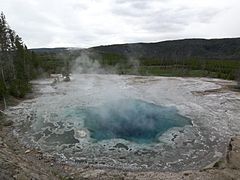Artemisia Geyser
| Artemisia Geyser | |
|---|---|
 | |
 | |
| Location | Upper Geyser Basin, Yellowstone National Park, Teton County, Wyoming |
| Coordinates | [1] |
| Type | Fountain Geyser |
| Eruption height | Up to 30 ft (9.1 m) |
| Frequency | 9 to 36 hours [2] |
| Duration | 15 to 25 minutes |
| Temperature | 177 °F (81 °C) [1] |
| Lua error in Module:Location_map at line 526: Unable to find the specified location map definition: "Module:Location map/data/NorthernSectionUpperGeyserBasin-Artemsia.jpg" does not exist. | |
Artemisia Geyser is a geyser in the Upper Geyser Basin of Yellowstone National Park in the United States.
Geology
Artemisia Geyser is part of the Cascade Group which includes the Atomizer Geyser. It erupts for a duration of 15 to 25 minutes once or twice per day. The fountain reaches a height of 30 feet (9.1 m). Artemisia's pool overflows quietly for many hours before an eruption, but gives no visible warning of an impending eruption until the sudden increase in overflow that marks the eruption's onset. Eruptions are accompanied by a strong underground thumping caused by steam bubbles collapsing in the geyser's channels.[3]
Artemisia also experiences minor eruptions lasting about 5 minutes. These minor eruptions are followed by major eruptions within six hours. Minor eruptions are rare. Years may pass between episodes of minor eruptions.
In 2009, intervals between eruptions ranged from 9 to 36 hours, averaging 18 hours, 43 minutes.[2]
References
- ^ a b "Artemisia Geyser". Yellowstone Geothermal Features Database. Montana State University.
- ^ a b "Artemisia Geyser Statistics for 2009". Geysers of Yellowstone. Geyser Observation and Study Association (GOSA).
- ^ "Artemisia Geyser". Geyser Observation and Study Association (GOSA).
External links
- "Video of Yellowstone - Artemisia Geyser 2009". Retrieved 2009-11-20.

